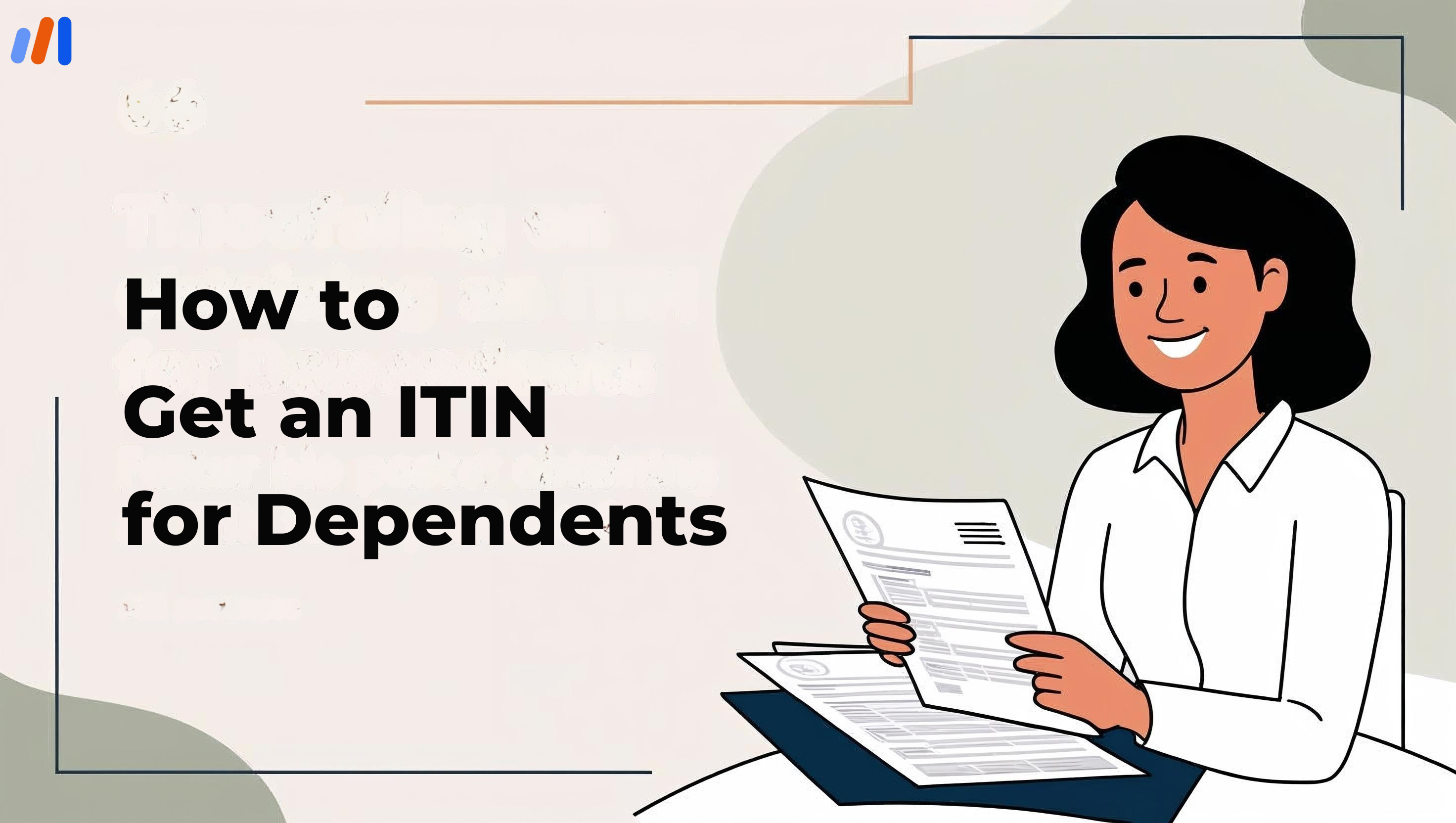Claiming someone as a tax dependent requires you to address certain criteria for them, one of which is assigning them a Social Security Number (SSN). If the SSN criterion does not fit your case, you will most likely have to apply for an Individual Taxpayer Identification Number (ITIN) instead.
This is particularly important for a family with foreign children, non-resident spouses, or relatives living abroad who have recently migrated to the U.S.
In this guide, we’ll discuss what an ITIN is, who applies for one, the documents needed, and the step-by-step application procedure.
If this is your first time filing taxes or you seek tax credits such as the Child Tax Credit and Earned Income Credit, you will most certainly need the ITIN application guide for dependents.
What does ITIN stand for?
ITIN refers to Individual Taxpayer Identification Number. It is a number provided by the Internal Revenue Service (IRS) to an individual who lacks an SSN and seeks a U.S tax identification number.
ITIN or Individual Taxpayer Identification Number is a number consisting of 9 digits and is equivalent to the American Social Security Number in structure, for example, it is stated as 9XX-XX-XXXX. An ITIN only serves one purpose, which is United States tax obligations. As such, it does not:
- Allow someone to work in the U.S.
- Permit someone to have welfare benefits from the government.
- Verify someone’s immigration status.
An ITIN is obtained by non-US residents, foreign citizens, children, or partners of American citizens or residents. In general, ITINs are given to people who are required to file taxes in the US. For dependents, having an ITIN means that they can be on a federal tax return to help the taxpayer gain certain exemptions or credits.
Who needs an ITIN for Dependents?
An ITIN must be obtained for a dependent who does not qualify for a Social Security Number and is claimed on a tax return. Some of such cases include:
- Children who are not US citizens or residents and were born outside the US.
- Children born outside the US who have been adopted and entered the US on a foreign national visa.
- Dependent relatives living outside the US who can be claimed as dependents.
You may require an ITIN for a dependent to:
- Claim the Child Tax Credit (additional rules regarding U.S. residency apply).
- Claim the Other Dependent Credit.
- Claim qualifying educational or childcare expenses or independent exemptions.
- Meet IRS obligations about Federal Income Tax (ITIN) on global income or other compliance obligations.
Dependents who are not citizens, nationals, or lawfully residing permanent residents of the US and do not have a work permit do not qualify for an SSN. They are highly likely to be dependents, and the only option is an ITIN.
It is important to remember that not all dependents, relatives, or children qualify to be claimed on a tax return. They have to fulfill the IRS dependency requirements, which entail relationship, age, residency, and support.
Requirements for Obtaining an ITIN for Dependents
The IRS has specific documentation and processes to follow when requesting an ITIN for a child under a taxpayer. The following documentation is required:
1. Completed Form W-7 for Each Dependent
The application for an IRS ITIN is Form W-7. This form requires you to:
- Identify the dependent’s full name, foreign address, and U.S. address (if applicable)
- Indicate the reason for applying (most often: “Dependent of U.S. citizen/resident alien”)
- Provide details of the supporting documentation
- Include the taxpayer’s (your) information if you’re claiming the dependent
Even if several dependents are being claimed on the same return, each dependent will need their own W-7 form.
2. A Valid Federal Tax Return (Usually Form 1040)
W-7 attached to 1040 Income Tax Return, along with other applicable schedules/to get W-7 exemption.
- Form 1040 or 1040-NR
- Any applicable schedules or supporting forms
- One or more W-7 forms (for each dependent without an SSN)
3. Original or Certified Documentation to Prove Identity and Foreign Status
Permissible documents for taxes have to be certified by the issuing institution. Overall, a government ID, especially a passport, tops the list of unassailable documentation. It is doubly serves as an assurance of identity and nationality, which is especially handy when it comes to minors.
In the absence of a passport, the following documents can be submitted in place:
- National ID card (must include a photo, name, date of birth, and expiration date)
- Birth certificate (usually required for children under 18)
- U.S. or foreign medical records (for dependents under 6)
- U.S. or foreign school records (for dependents under 18)
- Visa and U.S. immigration entry documents
The W-7 instructions have a listing of acceptable documents, which are subject to rigid IRS guidelines.
4. Proof of U.S. Residency for the Child Tax Credit (if applicable)
To claim the Child Tax Credit (CTC), the dependent is required to be residing within the U.S for over half of the tax year. This is an important consideration that needs supporting documentation of residency, which may be provided in the following ways:
- School documents showing attendance, along with a listed address within the United States.
- Medical records issued by American providers.
- U.S issued immigration documentation evidencing arrival into the country as well as the period of stay.
If residency is not proven, the child may still qualify as a dependent, but not for the Child Tax Credit.
Step-by-Step Process to Apply for a Dependent’s ITIN
Let’s discuss in stepwise detail how to fill out an application for your dependents’ ITINs.
Step 1: Collect and Organize All Necessary Documents
First and foremost, make sure you have the following documents on hand:
- An original or certified passport.
- Any other identity or residency verification documents.
- Proof of relationship, like a birth certificate or adoption papers.
- Residency verification documents are required if applying for the Child Tax Credit.
Be sure that the documents are valid, legible, and not expired.
Step 2: Fill Out the W-7 Form
Obtain a W-7 Form from the IRS website and fill it out. Always remember to use black ink and capital letters. Make sure to review:
- The names (spelling) are provided in the documents.
- Foreign address (the child, even if, lives in the USA).
- Codes regarding the reason and particular dependent data.
- Sign (by caretakers, if the child is below 18).
Step 3: Complete your Tax File
Fill in your federal tax return alongside the Child’s name, and the ITIN is “ITIN applied for” in the SSN field. Remember to include the W-7 forms.
Please note that tax returns cannot be e-filed while applying for an ITIN, and the application must be physically mailed.
Step 4: Submit the Application to the IRS
You have three options to submit your documents:
Mail to IRS ITIN Operation:
Send all documents via trackable mail to:
IRS ITIN Operation
P.O. Box 149342
Austin, TX 78714-9342
USA
Use a Certifying Acceptance Agent (CAA):
A CAA can verify original documents and submit your application on your behalf. This way, you do not need to send original documents to the IRS, which can minimize processing errors.
Apply at an IRS Taxpayer Assistance Center (TAC):
Schedule an appointment and apply in person. The IRS personnel will examine the documents and submit them on your behalf.
Step 5: Wait for IRS Processing
Typical processing time is 7–11 weeks, but may be longer during peak tax season or if documents are incomplete. The IRS issues an ITIN assignment letter upon approval of the application and a rejection notice when additional information is required.
Common Mistakes Not to Make
Avoiding these common mistakes, including disregarding certain requirements, can help slow down the application process and increase the chances of getting the application accepted.
- Returning photocopies of ID documents instead of original documents or certified copies.
- Not attaching a tax return with the application (there are exceptions, but they are few and far between).
- Using outdated versions or forms, like the incomplete W-7 form.
- Misspelling names and not cross-referencing other documents with the application.
- Missing proof of residency for the children claimed under the Child Tax Credit.
- Submitting the forms electronically. Remember that ITIN applications must be included in paper returns.
Renewing an Expired ITIN for a Dependent
An ITIN will expire if:
- It has not been claimed on a tax return three consecutive times.
- It was issued before 2013 and falls under the IRS’s rolling renewal program.
You can update the dependent’s ITIN by filling out the W-7 form tagged for upgrades, along with up-to-date paperwork. There is no need to include a tax return if you are simply renewing the application without claiming.
Other methods of submission include by mail, CAAs, or TACs.
Concluding Remarks
The process of applying for an ITIN can be complicated for a dependent, but following the guidelines with the correct documents should make the application process uninterrupted.
ITINs are vital for ITIN parents maximizing tax advantages as well as complying with tax legislations of the United States of America, either for a foreign-born child and immigrant family or for a taxpayer with eligible relatives living abroad.
For unclarified forms and prerequisites, speaking with a Certified Acceptance Agent, an IRS official, or a professional tax preparer is the best option.
Easyfiling will assist in document verification and walk you through the steps so that you do not incur unnecessary costs due to delays or rejections.
File Your LLC Today
25$ off with a coupon
Lock in EasyFiling's transparent rates and get lifetime compliance support at no extra cost.
Get Started Now







